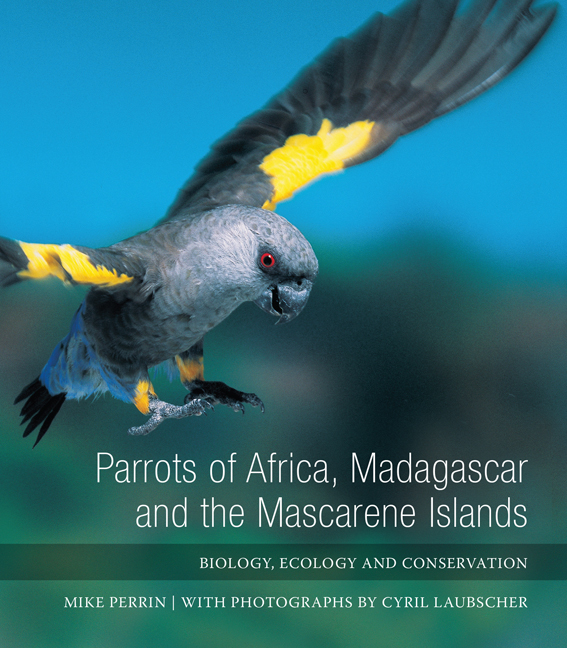Book contents
- Frontmatter
- Contents at a glance
- Contents
- Acknowledgements
- List of tables
- List of figures
- Abbreviations
- Chapter 1 Introduction
- Chapter 2 Conservation Biology
- Chapter 3 Systematics
- Chapter 4 Biogeography and Niche Separation
- Chapter 5 Intelligence, Communication and Behaviour
- Chapter 6 Breeding Biology
- Chapter 7 Diet and Metabolism
- Chapter 8 Case Study – The Cape Parrot
- Chapter 9 Trade in African parrots
- Chapter 10 African Parrot Conservation
- THE PARROT SPECIES OF AFRICA
- IUCN CATEGORIES
- Chapter 11 Long-Tailed and Fossil Parrots
- Chapter 12 True Parrots
- Chapter 13 Lovebirds
- Chapter 14 Field Techniques in Parrot Research
- Species lists
- Glossary
- Bibliography
- Index
Chapter 2 - Conservation Biology
Published online by Cambridge University Press: 04 June 2019
- Frontmatter
- Contents at a glance
- Contents
- Acknowledgements
- List of tables
- List of figures
- Abbreviations
- Chapter 1 Introduction
- Chapter 2 Conservation Biology
- Chapter 3 Systematics
- Chapter 4 Biogeography and Niche Separation
- Chapter 5 Intelligence, Communication and Behaviour
- Chapter 6 Breeding Biology
- Chapter 7 Diet and Metabolism
- Chapter 8 Case Study – The Cape Parrot
- Chapter 9 Trade in African parrots
- Chapter 10 African Parrot Conservation
- THE PARROT SPECIES OF AFRICA
- IUCN CATEGORIES
- Chapter 11 Long-Tailed and Fossil Parrots
- Chapter 12 True Parrots
- Chapter 13 Lovebirds
- Chapter 14 Field Techniques in Parrot Research
- Species lists
- Glossary
- Bibliography
- Index
Summary
IGNORANCE ABOUT THE SURVIVAL OF AFRICA'S PARROTS
In confronting the pressures facing Africa's parrots, the major constraint is a lack of knowledge. This need for more information is one of the overriding issues in African parrot conservation. Considering the interest in parrots in the Neotropics and Australasia, for example, the state of knowledge of Africa's parrots is very poor. Consequently, opportunities to raise awareness of the plight of African species among wildlife managers, legislators, researchers, birdwatchers and the public in general, must be grasped at every opportunity. More knowledge of the biology and ecology of the parrots is essential before their conservation status can be determined. For example, the Yellow-faced Parrot of Ethiopia is thought to have a very small distribution and to be dependent upon juniper– yellowwood (Juniperus–Podocarpus) forests but its biology and habitat were very poorly known until very recently. We know even less about the Niam-Niam Parrot Poicephalus crassus and Swindern's Lovebird Agapornis swindernianus. The Grey-headed Lovebird A. canus of Madagascar was previously thought to be common throughout most of the island (Langrand 1990), but now there is concern that trapping may affect its status in the wild (O. Langrand, personal communication).
The level of protection accorded to parrots by existing protected areas is variable. Whilst notification of an area as protected is no guarantee of security, it is the first step in assisting a species towards long-term survival. No comprehensive assessment exists of the extent to which protected areas are effective in maintaining parrot populations, but such knowledge as exists indicates considerable variation in the level of legal protection offered to African parrots. Some species are well represented in protected areas, such as Fischer's Lovebird A. fischeri, which has a substantial part of its range within the Serengeti National Park, Maswa Game Reserve and Ngorongoro Conservation area in north central Tanzania. Other species, however, including the critically endangered Cape Parrot Poicephalus robustus, are worryingly underrepresented and the range of the threatened Ruppell's Parrot P. rueppellii only abuts the Etosha National Park in Namibia. In some cases, protected areas may not be required.
- Type
- Chapter
- Information
- Parrots of Africa, Madagascar and the Mascarene IslandsBiology, Ecology and Conservation, pp. 27 - 64Publisher: Wits University PressPrint publication year: 2012



